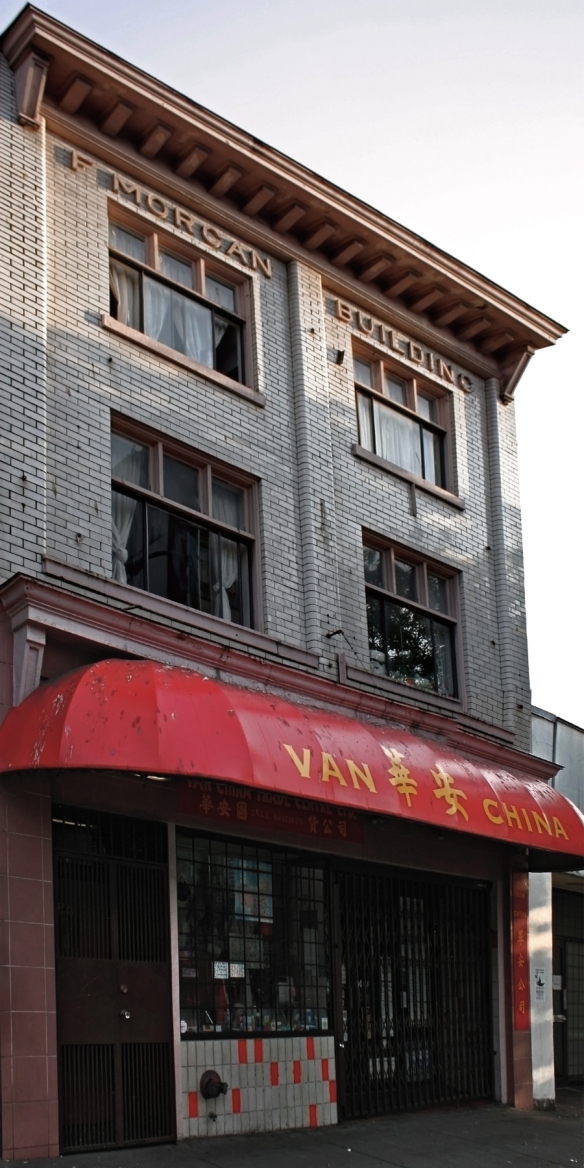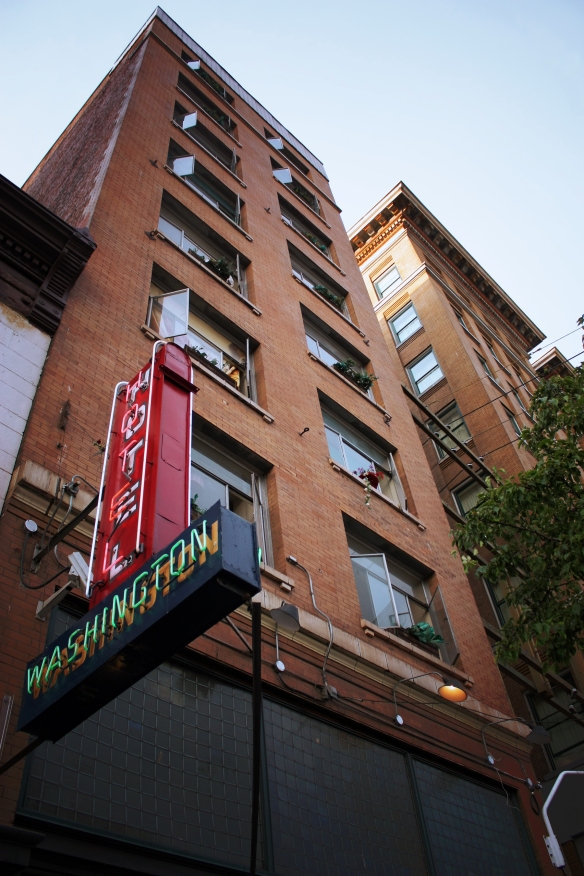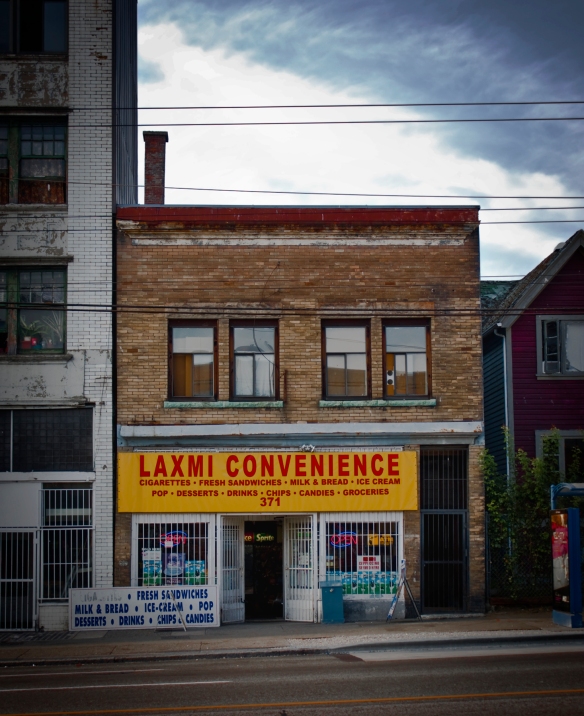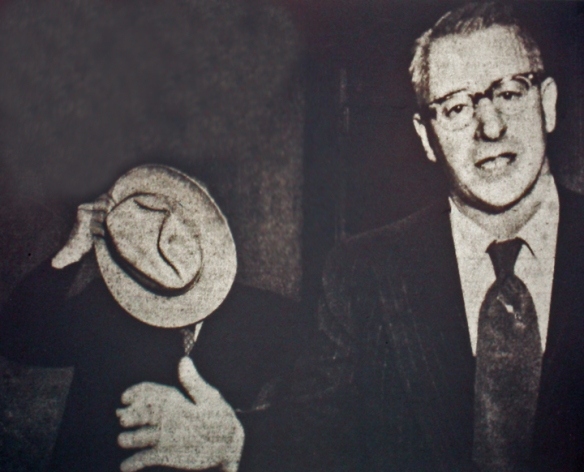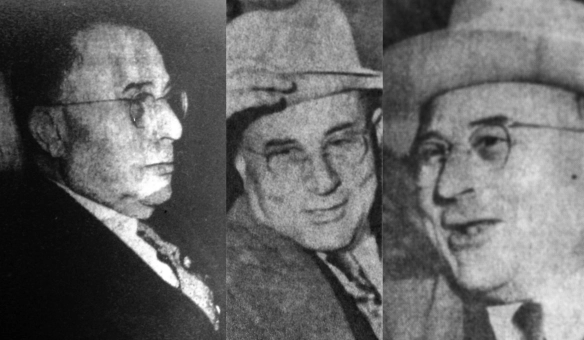
The Avenue Theatre, 11 June 1935. 102 East Georgia, just west of Main Street and home of the Lincoln Club, is the brick building right behind the theatre and in front of the Gasometer tower. City of Vancouver Archives #447-395
The Lincoln Club was an underground black social club in Vancouver in the late 1910s and early 1920s. It was located at 102 East Georgia Street, just west of Main, which means it was boxed in by the Avenue Theatre on the east and the original Georgia Viaduct on the north, and so was only accessible from below the viaduct and from the alley. During its six-year existence, it took on the role of the city’s earlier railway porters’ clubs as a social hub for Vancouver’s small black community and for performers passing through town on the vaudeville circuits.
The building that housed the Lincoln Club replaced an old horse stable, and first shows up as Central Rooms in 1911. It was a brick building with nineteen rooms, each equipped with a service bell, hot and cold running water, and steam-heat. It was one of the many rooming houses, or Single Room Occupancy (SRO) hotels, built during the 1908—1913 boom, but was probably fancier than most.
Shore Street
The names of the building’s neighbours listed in the 1911 city directory hint at the nature of the block when it was built: Andrea Morton, Blanche Douglas, Minnie Clayton, Nellie St Clair, Dolly Darlington, Alice Bernard, Blanche Lewis, Ollie Gilbert, Cleo Devere, Jewel Hall, and Kitty Clark. All women, and many with names that sound like hookers from an old west bordello.
Before WWI, red light districts were tolerated in Vancouver based on the idea that prostitution was inevitable, and so concentrating it in one area made it easier to police and minimized the impact of the “social evil” on the rest of the city. The 100 block of Harris Street (as East Georgia was known before the viaduct was built) became a red light district after the sex trade was chased out of Dupont Street and Shanghai and Canton alleys because a train station went in where International Village mall now stands. To allow the more “respectable” denizens of Harris Street east of Main to disassociate from these “undesirables,” the City renamed the 100 block “Shore Street” in 1908, although that name never caught on in popular usage.
![Lee Jones, an American "sporting girl" arrested as a "keeper of a disorderly house" for turning tricks in her room above the Utopian Club, a brothel at 169 Harris [Shore] Street on 22 July 1913. City of Vancouver Archives, VPD series #S202, Loc. 37-C-9](https://pasttensevancouver.files.wordpress.com/2014/12/sporting-girl-169-harris-1913.jpg?w=404&h=269)
Lee Jones was an American “sporting girl” arrested as a “keeper of a disorderly house” for turning tricks in her room above the Utopian Club, a brothel at 169 Harris [Shore] Street on 22 July 1913. City of Vancouver Archives, VPD series #S202, Loc. 37-C-9

A rare view of the brothels on the north side of Shore Street, shortly after the relocation of the “restricted district” to Alexander Street and during construction of the original Georgia Viaduct. CVA #LGN 1188 (cropped)
The Alexander Street brothels are a little more flamboyant than typical SROs, with more decorative features and custom flourishes designed to lure clientele and reflect the owner’s brand. They also differ in that the ground floors were not designed to be leased out as retail space, but rather as common areas that typically included a dining room, bar, and lounge with a piano for entertainment. Although much more modest in scale, Shore and Alexander streets were the closest thing Vancouver had to New Orleans’ famous red light district, Storyville, which happened to be shut down the year the Lincoln Club opened.

Brothels in the red light district era often had musicians on staff, such as William Morrison, the piano player at Mary Scott’s house at 666 Alexander Street. Morrison’s piano playing cost him a 30 day jail sentence as a “frequenter of a house of ill fame” during a 1913 crackdown. City of Vancouver Archives, VPD series #S202, Loc. 37-C-9
Prostitution continued on Shore Street at least until 1913 and construction of the first Georgia Viaduct began the same year. With the lucrative sex trade moving away and the viaduct practically dropped on the Lincoln Club building’s front doorstep, the value of the property plummeted. It was listed for rent in January on “easy terms,” and then for sale in March. “Will sell cheap,” says the ad.
In 1916, 102 East Georgia was owned by a miner named Charles Alexander who spent $1000 on a brick extension to the building. The first time the name “Lincoln Club” appears is when the phone line was installed in 1917. There’s no evidence of prostitution at the club, but there is for that other Storyville institution: jazz. The same year that the Lincoln opened, alcohol prohibition came into effect and kicked off Vancouver’s “jazz age.”
Oscar Holden
The most notable resident of 102 East Georgia was Oscar Holden, the band leader at the Patricia Cabaret, the hottest jazz venue in town at the time. By all accounts, Holden was a very skilled and talented musician, but his role in Vancouver seems to have been unfairly overshadowed and diminished by Jelly Roll Morton, one of the original jazz pioneers to come out of Storyville. In recalling his own time in Vancouver, Morton claimed to have been the bandleader at the Patricia, but all the extant evidence puts Holden in that role. In an interview with Alan Lomax, Jelly Roll pays Holden a backhanded compliment, saying he “was no hot man, but played plenty of straight clarinet.”
Oscar Holden left Vancouver for Seattle in the early 1920s and is remembered very differently there, as a pioneer and the patriarch of that city’s much larger and more viable hot jazz scene on Jackson Street. “Anything you set before him, he’s gone!” recalled a fellow Seattle musician. “He had a wonderful musical education. He was a great, great performer.” Indeed, Vancouver’s jazz history may have taken quite a different path had Holden not moved back to the States.
A major difference between Oscar Holden and Jelly Roll Morton is that Holden was looking to settle down in one place and raise a family. He came north from Tennessee to spare his children the grotesque racism he knew in the Jim Crow south. Jelly Roll, on the other hand, travelled incessantly and never settled down or raised a family. Aside from his musical abilities, one of Morton’s great talents was his gift for self-promotion and telling great stories in which he was the central figure. In his version of jazz age Vancouver, the Patricia Cabaret thrived under his musical stewardship and wilted at the moment of his departure, claims that are contradicted by all the other evidence. Jelly Roll also stands alone in crediting himself as the inventor of jazz.
Oscar Holden’s “Hoosier drummer,” William Hoy, also lived above the Lincoln Club. It’s unimaginable that they and other performers from the Patricia didn’t stop by the Lincoln after hours to jam, dance, gamble, and drink into the night, including George Paris, Ada Bricktop Smith, and Jelly Roll Morton, not to mention black entertainers passing through town, such as Bill “Bojangles” Robinson.

This is the only image I found of 102 East Georgia while the Lincoln Club was still operating. Detail from a WJ Moore panorama taken from the Sun Tower, June 1921. City of Vancouver Archives #PAN N221
The Lincoln Club in the Press
The Lincoln Club was run by Reg Dotson, a black man born in Missouri. Dotson frequently played host to entertainers passing through town, according to reports in the Chicago Defender, an important African American newspaper in the post-WWI period. The comedy duo Green and Pugh noted in a letter to the paper that “Reginald Dotson, who owns the finest club in Vancouver, was waiting at the pier for us in his big car, and that is the way we have been treated since leaving Chicago.” Tom Clark, described by the Defender as “well known to members of the profession,” reported in 1919 that he was now living in Vancouver and that mail could reach him at 102 East Georgia. A month later, a correspondent living at 940 Main Street, noted that “Tom Clark has a neat little cafe.” L Louis Johnson wrote in and said that while visiting Vancouver in 1921, “we dined with Reggy [Dotson] at his palatial home and Oh, such a meal.” Joe Sheftell, the manager of a vaudeville act called the Creole Fashion Revue, said that “Reggie Dotson gave a banquet last night and we had everything from soup to nuts.” In 1922, ET Rogers, who worked at the Patricia Cabaret and lived at 804 Main Street, informed the Defender that “Vancouver is still on the map … The Lincoln Club is still headquarters. It is the best club on the coast.” Another 1922 Defender report noted that the “Lincoln Club gave its annual breakfast dance Easter Sunday.”
Vancouver’s (white) press, meanwhile, painted a picture of the Lincoln Club as nothing more than a disorderly house. The first of only two incidents that earned Dotson and his club coverage in the local papers was a police raid in December 1919. “Among the colored members four white girls were found,” reported the World. Dotson was fined $50 plus costs for keeping a gaming house and $300 for “having liquor illegally in possession” under the Prohibition Act. Thirty-nine “inmates” found there were each fined $15 plus costs. We can only imagine how the presence of white women influenced the case.
The Extortion Case
The second newsworthy incident at the Lincoln Club took place in the spring of 1923 when a man named George McLeod came in claiming to be the chief inspector of the BC Liquor Control Board. According to Reg Dotson, McLeod told him that the unsealed liquor that had previously been confiscated from the club meant that Dotson was facing a $100 fine. “We don’t like to prosecute these cases,” McLeod said, “because the city gets all the money and we do all the work. The liquor board or government don’t get the fines.” McLeod gave Dotson the option of handing over $50 cash to ensure the matter would be dropped. Dotson was skeptical that McLeod was who he claimed to be and wasn’t too keen on being shaken down. He told McLeod to come back at 8 pm and in the meantime spoke with Inspector Charles Tuley of the Vancouver Police Department.

Charles Tuley was the Vancouver Police Inspector who coordinated the police sting operation at the Lincoln Club that snared George McLeod, a provincial liquor inspector. McLeod attempted to extort $50 from Reg Dotson in 1923. Photo by AJ Selset, 1914 or 1915, CVA #A-30-244
Dotson assisted the police in the sting that caught McLeod. The two men met downtown in Dotson’s car and spoke again on the phone (with the police listening in) to discuss the payoff. Dotson stalled by pressing McLeod for assurances that he wouldn’t be fined anyway after handing over the cash. The final meeting was at Dotson’s “palatial home” at 102 East Georgia. Dotson answered the door in his pajamas to appear like he had just woken up. McLeod came in to complete the transaction, unaware that police were hiding in an adjacent room listening to the conversation and peeping through a keyhole. Dotson handed McLeod $50 in marked bills supplied by the police. Inspectors Tuley and Sutherland and Detective Thompson burst out and arrested McLeod. When told at the police station that he “had been a fool,” McLeod replied: “I know. I wish I hadn’t. Keep this quiet and I will quit my job and leave the country,” according to Tuley’s testimony.
The case went to court in the fall of 1923. McLeod’s defense was simple. Rather than refuting the testimony of Dotson and the police, he claimed that he did what he did to find out which clubs were paying off the police to look the other way. Dotson took the stand, followed by Tuley and Thompson, who corroborated his version of events. McLeod’s explanation won the day and he was acquitted.

Looking east toward Main Street during construction of the first Georgia Viaduct around 1914. The large building is the rear of the Avenue Theatre and just below it is the top of 102 East Georgia Street. City of Vancouver Archives #LGN 1188 (cropped)
The papers don’t specify what made McLeod’s story more compelling than that of his accusers. It may have been simply the widespread belief at the time that the city police force was thoroughly corrupt. When asked in court if he had heard of payoffs being made to the police, Inspector Tuley replied: “to hear some people, every club in the city is paying for police protection.” The verdict may also have been influenced by the heightened anti-black racism in the city that followed the killing of a Victoria Cross-decorated police officer by a black man the previous fall. No doubt the cooperation between a black club owner and the police in a sting operation would have raised suspicions in many people’s minds in 1923.
The defense brought in two of McLeod’s underlings from the Liquor Control Board. One said that McLeod had mentioned his plan to entrap Dotson, but he didn’t question it because he “figured McLeod knew more about the business than he did.” Another said that part of his job was to report on the “beer club situation,” and that “the Lincoln Club was one of the worst in the city and was frequented by colored men and white girls, and he understood Mr McLeod was trying to get evidence.” The paper didn’t say what relevance the racial makeup of Lincoln Club patrons had to the case.
Before a verdict was reached, a “lady juror” was rebuked by the judge for remarking that she hoped McLeod got off because it looked like “a frame-up” to her, but her reasoning wasn’t reported. One of the officers “admitted under cross-examination that the police had been compelled to adopt certain methods, which he did not approve of, to secure convictions under the Liquor Act, and that in some instances ‘informers’ used had turned out to be rotters.”
McLeod’s lawyer grilled Dotson about the club, bringing up its history of alleged liquor violations. Dotson said that he shut the club down in October of 1922 and that since then the space was being used by black railway porters. When asked if it was operating as an illegal gambling den, he refused to answer on the grounds that he would not incriminate himself.
Conclusions

BC Hydro’s Murrin Substation, at the southwest corner of Main and East Georgia streets, under construction in 1946. This is the building that still occupies the old Avenue Theatre site on Main at East Georgia Street. If you click to enlarge the image you can see that the Lincoln Club building has been replaced with what appears to be storage shacks between the two billboards. Photo by Don Coltman, CVA #586-4792
There is very little documentation of the Lincoln Club, but enough to confidently draw some conclusions about its significance. The club was popular, given the police attention it received and its six year existence. Reg Dotson’s “big car” and his ability to routinely host and impress entertainers passing through town tell us that he was more than just eking out a living from the club. Certainly he was financially far better off than if he had worked as a sleeping car porter, janitor, or the handful of other legitimate occupations open to black men at the time.
The unexplained mentions of “white girls” in newspaper reports almost certainly were intended to add to the club’s notoriety by adding race-mixing to the other so-called vices committed at the Lincoln Club. But it also tells us that the social scene there was not racially insular despite being explicitly a black club. The annual Easter Sunday breakfast dance suggests that it had a community purpose beyond just drinking and gambling. And from the various performers that lived above or passed through the club we can reasonably assume that a vibrant musical subculture made itself at home there, specifically, jazz, right at the moment when the genre was beginning to come into its own.
Vancouver’s black population was tiny at the time, but in another sense, the black culture at the Lincoln Club was indistinct from the large and sophisticated black cultural network that traversed the continent on the railway lines and entertainment circuits. In subsequent decades, the culture being incubated in thousands of small venues like the Lincoln Club would slowly become woven into mainstream popular culture, in Vancouver and around the globe.
102 East Georgia was listed as “vacant” in the 1925 directory. Reg Dotson died ten years later.







